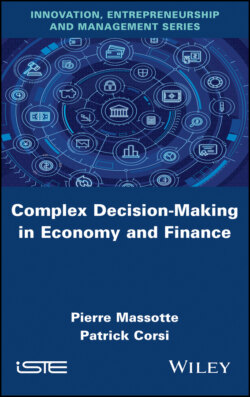Читать книгу Complex Decision-Making in Economy and Finance - Pierre Massotte - Страница 23
1.1.2. What are the problems to be solved?
ОглавлениеThe ultimate objective – the purpose – of a complex system is the gain, which means that it tries to achieve, collectively, an overall objective. We therefore continue here on the topic of intentions, but not on firm and rational commitments, rather “safe” strategies to achieve an overall optimum. Indeed, in a programmable network, comprising many interacting elements and complex behavior, we are confronted with strange attractors; we cannot predict in advance the attractor on which we are, at which precise point in the cycle we are and at which precise horizon we will have converged. Methodological elements need to be defined to identify which sets of objectives can be achieved.
We can be inspired by the approaches used in the game of checkers for example. In this case and according to a context, each partner, when playing, chooses a tactic and explores the moves as much as possible; he or she tries to anticipate the opponent’s reactions, evaluates them and decides on the least bad or best possible movement. By doing so, the player optimizes an economic function over a given time horizon. On the contrary, to accelerate the process and according to past experiences, he or she will be led to carry out reflex actions that are the result of winning repetitive strategies and that will have been the subject of successive learning. In this simple example, relating to a specific game, we see an interesting approach emerging:
– it is a system in which agents are intelligent (i.e. with behavior capable of emulating, in part, that of the human brain), autonomous, capable of communicating or exchanging information with partners or agents, with whom they are in a competitive or cooperative situation (hence the notion of conflicting objectives!);
– it is a situation and a mode of operation that we encounter, to a greater or lesser extent, in any distributed system and whatever the field considered. For example, we can cite decision-making problems in industry, the evolution of the immune system in a cell, the phenomena of metabolic adaptation in a living being, the flexibility of the behavior of a population of individuals in the context of the human and social sciences, etc.;
– understanding how global objectives and behaviors can emerge is a key factor in guiding the evolution of complex systems at the structural, organizational and operational levels, in order to move step by step towards a predefined goal.
Many other examples exist in chemistry, economics, metabolism, the immune system, etc. However, communication techniques between agents based on game theory make it possible to define very elaborate strategies whose evolutions and results are impossible to guess. Indeed, several elements specific to a complex system come into play:
– there are many interactions in a given neighborhood;
– each element modifies not only its own state, but also that of its close neighbors, according to rules with a low visibility horizon;
– the objectives are local but it is common for them to overlap with those of the neighborhood and to be in conflict with others;
– each element tries to improve a number of its own properties and reduce the least valuable or effective ones in relation to a given criterion.
From these examples, it can easily be deduced that the strategies and tactics commonly used in production or industrial engineering are not applicable here. Indeed, the systems we currently have are not decomposable and are nonlinear. Moreover, because of all the existing diffuse feedback, it is impossible to start from a global objective (linked to quality or performance) and apply it to the subsystems and finally to the agents, i.e. the elementary components of the system.
For this, and in order to deduce how to proceed in practice, we can refer to Sontag’s work in Mathematical Control Theory [SON 98]. This work describes how to make local adjustments to system parameters to achieve certain objectives.
However, a different approach in Control Theory, based on Horowitz’s work [ALB 02], consists of designing feedback loops and links such that they allow the system to evolve within predefined tolerance bands.
Finally, the strategies developed by IBM as part of the Deep Blue project in the 1990s to improve decision-making processes (with the famous application to chess games) are remarkable in the sense that they combine the concepts we have just mentioned with learning techniques.
